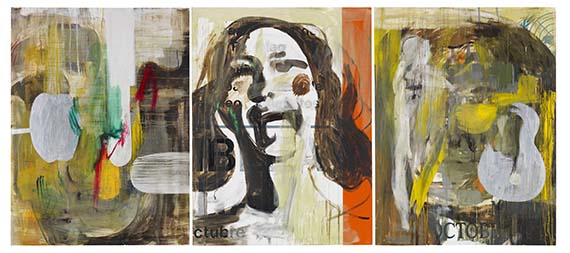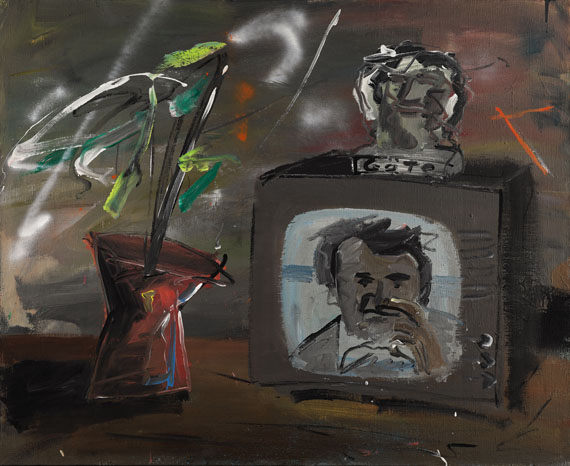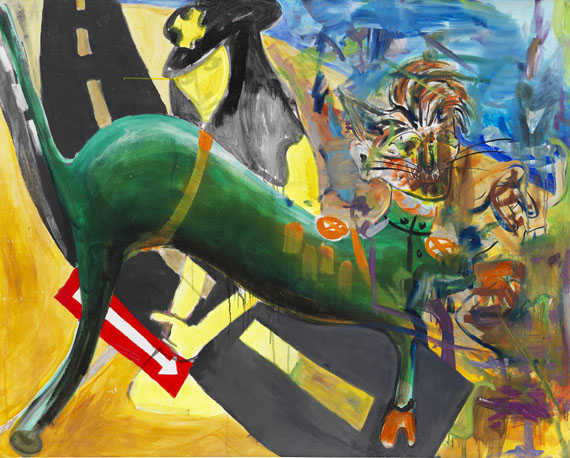324
Albert Oehlen
mit André Butzer (1973 Stuttgart) und Schorsch Kamerun (d. i. Thomas Sehl, 1963 Timmendorfer Strand). Walker, 1999.
Oil on canvas
Estimate:
€ 80,000 - 120,000
$ 88,000 - 132,000
mit André Butzer (1973 Stuttgart) und Schorsch Kamerun (d. i. Thomas Sehl, 1963 Timmendorfer Strand). Walker. 1999.
Oil on canvas.
Signed, dated and titled by all three artists on the reverse of the canvas. 120 x 150 cm (47.2 x 59 in).
[AR].
• Typical joint work for Albert Oehlen, in this case with André Butzer and Schorsch Kamerun.
• Comparable collaborations with artist friends are a special feature of Albert Oehlen's work.
• He is considered one of the protagonists of German New Expressionism.
• First exhibited on the occasion of the “Steirischer Herbst” at Galerie Bleich-Rossi in Graz the year it was made.
PROVENANCE: Galerie Bleich-Rossi, Graz.
Private collection, Steiermark.
Private collection, Hesse.
EXHIBITION: New Stream. Albert Oehlen, André Butzer, George Kamerun, Galerie Bleich Rossi, Graz, September 25 - October 24, 1999.
"The pictures, whether good or bad, pretty or ugly, assert themselves without any excuses. No magic, no science, no explanations.."
Albert Oehlen, ohne Jahr, quoted from: Kritisches Lexikon der Gegenwartskunst, Albert Oehlen, volume 29, Munich 1995, p. 14.
Called up: December 7, 2024 - ca. 16.17 h +/- 20 min.
Oil on canvas.
Signed, dated and titled by all three artists on the reverse of the canvas. 120 x 150 cm (47.2 x 59 in).
[AR].
• Typical joint work for Albert Oehlen, in this case with André Butzer and Schorsch Kamerun.
• Comparable collaborations with artist friends are a special feature of Albert Oehlen's work.
• He is considered one of the protagonists of German New Expressionism.
• First exhibited on the occasion of the “Steirischer Herbst” at Galerie Bleich-Rossi in Graz the year it was made.
PROVENANCE: Galerie Bleich-Rossi, Graz.
Private collection, Steiermark.
Private collection, Hesse.
EXHIBITION: New Stream. Albert Oehlen, André Butzer, George Kamerun, Galerie Bleich Rossi, Graz, September 25 - October 24, 1999.
"The pictures, whether good or bad, pretty or ugly, assert themselves without any excuses. No magic, no science, no explanations.."
Albert Oehlen, ohne Jahr, quoted from: Kritisches Lexikon der Gegenwartskunst, Albert Oehlen, volume 29, Munich 1995, p. 14.
Called up: December 7, 2024 - ca. 16.17 h +/- 20 min.
The joint work, “Walker” by Albert Oehlen, André Butzer, and Schorsch Kamerun, was first shown in the context of the “Steirischer Herbst” art festival at Galerie Bleich-Rossi in 1999. All three artists participated several times in this Austrian contemporary art festival, which is still considered a pioneering event today. It took place for the first time in the seminal year of 1968 and has placed focus on interdisciplinary exchange ever since.
In the present large work by the three German artists, a bright green, sphinx-like creature leaps through the picture, its New Wave head sporting a wild mane. Epaulettes suggest a cool uniform jacket. A road leads into the distance behind it, and a stage diva reminiscent of the YMCA policeman is kneeling. This work raises questions concerning otherness. This topic is very much in line with the festival of that time and the associated “question of how to deal with the other and the appropriation and exclusion of the minoritarian, the emergence of hybrid identities and the disturbances of the body, the reflection on the work of art as a product of the division of and the conditions of its production,” as the former artistic director Christine Frisinghelli put it (https://archiv.steirischerherbst.at/de/editions/1999, accessed October 18, 2024).
Oehlen, Butzer, and Kamerun all grew up during the punk era and new wave; the “Neue Wilden” (New Wild Ones) coincided with the renewal of figurative art in the Federal Republic of Germany. Here, the three artists reflect on a past that they have personally experienced. While Butzer and Oehlen are primarily known as visual artists, Schorsch Kamerun is best known as the singer of the punk band “Die goldenen Zitronen” and today also works as a director at major theaters such as the Zurich Schauspielhaus and the Munich Kammerspiele. Albert Oehlen is not only considered one of the leading representatives of “post-non-representational painting” but also one of those European artists who, as early as in the early 1980s, were willing to paint pictures that are still considered the basis for everything regarded “worthwhile seeing” in the early 21st century. [EH/AR]
In the present large work by the three German artists, a bright green, sphinx-like creature leaps through the picture, its New Wave head sporting a wild mane. Epaulettes suggest a cool uniform jacket. A road leads into the distance behind it, and a stage diva reminiscent of the YMCA policeman is kneeling. This work raises questions concerning otherness. This topic is very much in line with the festival of that time and the associated “question of how to deal with the other and the appropriation and exclusion of the minoritarian, the emergence of hybrid identities and the disturbances of the body, the reflection on the work of art as a product of the division of and the conditions of its production,” as the former artistic director Christine Frisinghelli put it (https://archiv.steirischerherbst.at/de/editions/1999, accessed October 18, 2024).
Oehlen, Butzer, and Kamerun all grew up during the punk era and new wave; the “Neue Wilden” (New Wild Ones) coincided with the renewal of figurative art in the Federal Republic of Germany. Here, the three artists reflect on a past that they have personally experienced. While Butzer and Oehlen are primarily known as visual artists, Schorsch Kamerun is best known as the singer of the punk band “Die goldenen Zitronen” and today also works as a director at major theaters such as the Zurich Schauspielhaus and the Munich Kammerspiele. Albert Oehlen is not only considered one of the leading representatives of “post-non-representational painting” but also one of those European artists who, as early as in the early 1980s, were willing to paint pictures that are still considered the basis for everything regarded “worthwhile seeing” in the early 21st century. [EH/AR]
324
Albert Oehlen
mit André Butzer (1973 Stuttgart) und Schorsch Kamerun (d. i. Thomas Sehl, 1963 Timmendorfer Strand). Walker, 1999.
Oil on canvas
Estimate:
€ 80,000 - 120,000
$ 88,000 - 132,000
Buyer's premium, taxation and resale right compensation for Albert Oehlen "mit André Butzer (1973 Stuttgart) und Schorsch Kamerun (d. i. Thomas Sehl, 1963 Timmendorfer Strand). Walker"
This lot can be purchased subject to differential or regular taxation, artist‘s resale right compensation is due.
Differential taxation:
Hammer price up to 800,000 €: herefrom 32 % premium.
The share of the hammer price exceeding 800,000 € is subject to a premium of 27 % and is added to the premium of the share of the hammer price up to 800,000 €.
The share of the hammer price exceeding 4,000,000 € is subject to a premium of 22 % and is added to the premium of the share of the hammer price up to 4,000,000 €.
The buyer's premium contains VAT, however, it is not shown.
Regular taxation:
Hammer price up to 800,000 €: herefrom 27 % premium.
The share of the hammer price exceeding 800,000 € is subject to a premium of 21% and is added to the premium of the share of the hammer price up to 800,000 €.
The share of the hammer price exceeding 4,000,000 € is subject to a premium of 15% and is added to the premium of the share of the hammer price up to 4,000,000 €.
The statutory VAT of currently 19 % is levied to the sum of hammer price and premium. As an exception, the reduced VAT of 7 % is added for printed books.
We kindly ask you to notify us before invoicing if you wish to be subject to regular taxation.
Calculation of artist‘s resale right compensation:
For works by living artists, or by artists who died less than 70 years ago, a artist‘s resale right compensation is levied in accordance with Section 26 UrhG:
4 % of hammer price from 400.00 euros up to 50,000 euros,
another 3 % of the hammer price from 50,000.01 to 200,000 euros,
another 1 % for the part of the sales proceeds from 200,000.01 to 350,000 euros,
another 0.5 % for the part of the sale proceeds from 350,000.01 to 500,000 euros and
another 0.25 % of the hammer price over 500,000 euros.
The maximum total of the resale right fee is EUR 12,500.
The artist‘s resale right compensation is VAT-exempt.
Differential taxation:
Hammer price up to 800,000 €: herefrom 32 % premium.
The share of the hammer price exceeding 800,000 € is subject to a premium of 27 % and is added to the premium of the share of the hammer price up to 800,000 €.
The share of the hammer price exceeding 4,000,000 € is subject to a premium of 22 % and is added to the premium of the share of the hammer price up to 4,000,000 €.
The buyer's premium contains VAT, however, it is not shown.
Regular taxation:
Hammer price up to 800,000 €: herefrom 27 % premium.
The share of the hammer price exceeding 800,000 € is subject to a premium of 21% and is added to the premium of the share of the hammer price up to 800,000 €.
The share of the hammer price exceeding 4,000,000 € is subject to a premium of 15% and is added to the premium of the share of the hammer price up to 4,000,000 €.
The statutory VAT of currently 19 % is levied to the sum of hammer price and premium. As an exception, the reduced VAT of 7 % is added for printed books.
We kindly ask you to notify us before invoicing if you wish to be subject to regular taxation.
Calculation of artist‘s resale right compensation:
For works by living artists, or by artists who died less than 70 years ago, a artist‘s resale right compensation is levied in accordance with Section 26 UrhG:
4 % of hammer price from 400.00 euros up to 50,000 euros,
another 3 % of the hammer price from 50,000.01 to 200,000 euros,
another 1 % for the part of the sales proceeds from 200,000.01 to 350,000 euros,
another 0.5 % for the part of the sale proceeds from 350,000.01 to 500,000 euros and
another 0.25 % of the hammer price over 500,000 euros.
The maximum total of the resale right fee is EUR 12,500.
The artist‘s resale right compensation is VAT-exempt.




 Lot 324
Lot 324 



